Overview
- Brief Narrative
- Charcoal drawing of a woman and child behind a fence created by Halina Olszewski (later Olomucki) in 1944 when she was a prisoner in Auschwitz-Birkenau concentration camp. It depicts a scene from her experiences in Warsaw Ghetto from 1940-1943. Nazi Germany occupied Poland in September 1939, and, in fall 1940, Halina, her mother Margarit-Hadassa, and siblings were relocated to the ghetto. Halina did forced labor, but she felt her real job was to record the misery and suffering of ghetto residents. Halina smuggled many drawings to a non-Jewish friend outside the ghetto. In May 1943, she and her mother were deported to Majdanek where her mother was killed on arrival. In July, Halina was sent to Auschwitz-Birkenau, where she continued to create art in secret. Other prisoners asked her to draw them or their loved ones, to preserve their memory and show the world what happened. She hid artwork in the camp, much of it recovered postwar. On January 18, 1945, Halina was sent by death march to Ravensbrück and Neustadt-Glewe, where she was liberated on May 2, 1945. She returned to Warsaw but found no surviving family members.
- Artwork Title
- Ghetto de Varsovie cachette pendant la raffle, Birkenau, 1944
- Alternate Title
- Warsaw Ghetto: Hideout During the Raffle, Birkenau, 1944
- Date
-
creation:
1944
- Geography
-
creation:
Birkenau (Concentration camp);
Birkenau (Germany)
- Credit Line
- United States Holocaust Memorial Museum Collection
- Signature
- front, bottom, pencil : 1944 H.O. / HALiNA
- Contributor
-
Artist:
Halina Olomucki
Subject: Halina Olomucki
- Biography
-
Halina Olszewski (later Olomucki/Olomucka) was born on November 24, 1919, in Warsaw, Poland, to Andrzej and Margarit-Hadassa Olszewski. She had an older brother, Moniek, born in 1909, and two sisters. Her parents ran a newspaper distribution service. Her father died in 1924. The family was Jewish but not observant. Halina attended a Yiddish speaking elementary school, then a public gymnasium.
Poland was invaded by Nazi Germany on September 1, 1939. German troops entered Warsaw on September 29. Halina and her family were relocated to the ghetto. Jews had to wear armbands with Judenstern, valuables were confiscated, and forced labor was required. Halina had drawn constantly from an early age and she continued to do this in the ghetto. She felt an urgent need to record daily life, even though, as she recalled: "I was in the same condition as every other person all around me. I saw them close to death but I never thought of myself close to death.... My job was simply to write down, to draw what was happening." Halina depicted the misery and suffering of life in the ghetto, where nearly 100,000 people died within the first fifteen months from disease and starvation. She also recorded events such as selections, deportations from the Umschlagplatz, or holding place, near the railroad station, and the destruction of Dr. Janos Korczak’s orphanage. While doing forced labor outside the ghetto, Halina smuggled drawings out to a Polish friend in the Aryan section, dropping small packages of drawings as her brigade walked by. On some occasion, Halina also smuggled in food for her family
In May 1943, after three days of waiting in the Umschlagplatz without food or water, Halina and her mother were put into a crowded train car and taken to Majdanek concentration camp. Her mother was sent to be killed upon arrival. Halina survived four selections done to separate those to be gassed from those to be used as laborers. One day, a guard came into the barracks and asked if there was anyone who knew how to paint and Halina volunteered. The work was drawing slogans on the walls, for which she received coffee and several slices of bread. The camp administrators liked her work and found other art projects for her. In July 1943, Halina was transferred to Auschwitz-Birkenau where she was tattooed with the number 48652. She was assigned to Block 10 whose residents were used for experimental medical atrocities. Halina was a slave laborer in an ammunition factory, and then was assigned to paint signs and slogans for the barracks. The slogans were about things like keeping clean and washing your hands, even though there was not even water to drink, much less wash, and living conditions were primitive and filthy. She also did sketches for the SS guards. She received increased rations of bread and cheese which she believed kept her alive. Halina hid pencil stubs and supplies from work, and secretly drew on any paper she could find, tissue and cigarette rolling paper, or scraps of discarded graph paper and reports. She had watercolors, but brushes had to be fashioned from cardboard strips. She made works based on her observations of the people and activities around her. Many prisoners implored her to draw their portraits believing that Halina was likely to survive. She hid her drawings in different spots around the camp, and in floors and walls near her bunk. She destroyed many works because of the constant fear of discovery. Halina was beaten often, and after the October 1944 revolt, spent days standing for exhaustive rolls calls and watched friends being murdered by guards. As Soviet forces neared, the camp was evacuated by death march on January 18, 1945, to Ravensbrück, and then to Neustadt-Glewe, where Halina was liberated by the Allies on May 2, 1945.
Halina returned to Warsaw after the war ended in May. She found no surviving family members. She recovered drawings she had smuggled out of Warsaw Ghetto and later some works from Birkenau. From 1945-1947, she created artworks as her eyewitness testimony of all she had seen and experienced during the Shoah. In 1945, she married Boleslaw Olomucki, who became an architect, with training from the Art Academy in Łódź and Warsaw Polytechnic. Boleslaw, born in Łódź on November 10, 1921, had been interned in the ghetto in 1940. On August 27, 1944, he was sent to Auschwitz-Birkenau concentration camp, then in October, transferred to Braunschweig/Neuengamme as slave labor. In March 1945, he was sent on a death march to Ravensbrück, then to Wobbelin where he was liberated. The couple moved to Łódź, where Halina studied at the Art Academy until 1950. The first exhibition of her artwork was in 1949 in Warsaw. She and Boleslaw had a daughter Miriam in 1951. In 1957, the family moved to Paris, France. Halina exhibited widely in Paris and London during the 1960s. In 1972, the family immigrated to Israel. Halina, 87, passed away on April 9, 2007, in Ashkelon, Israel.
Physical Details
- Classification
-
Art
- Category
-
Drawings
- Object Type
-
Prisoners in art (lcsh)
- Physical Description
- Drawing in charcoal and pencil on paper adhered to pressboard of the scared faces of a woman and a young girl behind a fencelike grid. The child has wide round eyes and the her lips form an O. She wears a tied headscarf and stands with her back on the woman's chest. The woman's face is lined and emaciated. She has straight, dark, shoulder length hair, thick eyebrows, large, tired, anxious eyes, and pursed lips. The woman's figure is bordered with dark shading and the child is surrounded by light. It is signed and dated.
- Dimensions
- overall: Height: 18.000 inches (45.72 cm) | Width: 14.000 inches (35.56 cm)
pictorial area: Height: 7.875 inches (20.003 cm) | Width: 5.125 inches (13.018 cm) - Materials
- overall : paper, charcoal, graphite
Rights & Restrictions
- Conditions on Access
- No restrictions on access
- Conditions on Use
- Restrictions on use. Copyright status unknown.
Keywords & Subjects
- Topical Term
- Autobiographical memory in art--Pictorial works. Jewish children in the Holocaust--Pictorial works. Concentration camp inmates as artists. Holocaust survivors. Holocaust, Jewish (1939-1945), in art. Holocaust, Jewish, (1939-1945)--Poland--Warsaw. Jewish women artists--20th century.
- Personal Name
- Olomucka, Halina, 1921-2007.
- Corporate Name
- Getto warszawskie (Warsaw, Poland)
Administrative Notes
- Legal Status
- Permanent Collection
- Provenance
- The drawing was acquired by the United States Holocaust Memorial Museum in 1989.
- Funding Note
- The cataloging of this artifact has been supported by a grant from the Conference on Jewish Material Claims Against Germany.
- Record last modified:
- 2023-10-26 10:02:55
- This page:
- https://collections.ushmm.org/search/catalog/irn1185
Download & Licensing
In-Person Research
- By Appointment
- Request 21 Days in Advance of Visit
- Plan a Research Visit
- Request to See This Object
Contact Us
Also in Halina Olomucki collection
The collection consists of eleven drawings created by Halina Olszewski (later Olomucki) during and after the Holocaust as her eyewitness testimony of people and scenes she saw and experienced in the Warsaw ghetto in Poland and as a prisoner in Majdanek, Auschwitz-Birkenau, Ravensbruck, and Neustadt-Glewe concentration camps.
Date: 1941-1947
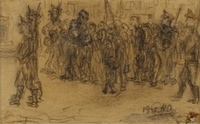
Halina Olomucki drawing of man and children taken by armed guards
Object
Drawing depicting Janusz Korczak and children being taken from Warsaw Ghetto created by Halina Olszewski, 24, (later Olomucki) in the ghetto in 1943. Germany occupied Poland in September 1939, and established the ghetto in October 1940. Dr. Korczak ran a Jewish orphanage in the ghetto. In July 1942, the Germans began mass deportations to Treblinka killing center. Korczak was offered a chance to escape, but refused to abandon the children. On August 6, Korczak led his staff and about 200 children in an orderly walk to the deportation train. Halina, her mother Margarit-Hadassa, and siblings were relocated to the ghetto in 1940. Halina did forced labor, but she felt her real job was to record the misery and suffering of ghetto residents. Halina smuggled drawings to a non-Jewish friend outside the ghetto. In May 1943, she and her mother were deported to Majdanek where her mother was killed on arrival. In July, Halina was sent to Auschwitz-Birkenau, where she continued to create art in secret. Other prisoners asked her to draw them or their loved ones to preserve their memory and show the world what happened. She hid artwork in the camp, much of it recovered postwar. On January 18, 1945, Halina was sent by death march to Ravensbrück and Neustadt-Glewe, where she was liberated on May 2, 1945. She returned to Warsaw but found no surviving family members.
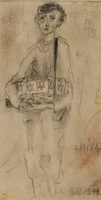
Halina Olomucki sketch of a boy selling Star of David armbands
Object
Pencil drawing of a sick, emaciated boy selling Star of David armbands created by Halina Olszewski, 24, (later Olomucki) while interned in Warsaw Ghetto in 1941. Nazi Germany occupied Poland in September 1939, and, in fall 1940, Halina, her mother Margarit-Hadassa, and siblings were relocated to the ghetto. Halina did forced labor, but she felt her real job was to record the misery and suffering of ghetto residents. Halina smuggled many drawings to a non-Jewish friend outside the ghetto. In May 1943, she and her mother were deported to Majdanek where her mother was killed on arrival. In July, Halina was sent to Auschwitz-Birkenau, where she continued to create art in secret. Other prisoners asked her to draw them or their loved ones, to preserve their memory and show the world what happened. She hid artwork in the camp, much of it recovered postwar. On January 18, 1945, Halina was sent by death march to Ravensbrück and Neustadt-Glewe, where she was liberated on May 2, 1945. She returned to Warsaw but found no surviving family members.
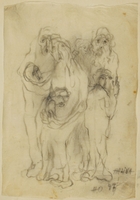
Halina Olomucki drawing of adults embracing children afraid of being killed
Object
Pencil drawing of several ghostly and anguished children and adults created by Halina Olszewski (later Olomucki) after the war. It expresses her memories of selections in Warsaw Ghetto, where children and the elderly who were not able to work, were the first to be chosen for deportation to killing centers. Nazi Germany occupied Poland in September 1939, and, in fall 1940, Halina, her mother Margarit-Hadassa, and siblings were relocated to the ghetto. Halina did forced labor, but she felt her real job was to record the misery and suffering of ghetto residents. Halina smuggled many drawings to a non-Jewish friend outside the ghetto. In May 1943, she and her mother were deported to Majdanek where her mother was killed on arrival. In July, Halina was sent to Auschwitz-Birkenau, where she continued to create art in secret. Other prisoners asked her to draw them or their loved ones, to preserve their memory and show the world what happened. She hid artwork in the camp, much of it recovered postwar. On January 18, 1945, Halina was sent by death march to Ravensbrück and Neustadt-Glewe, where she was liberated on May 2, 1945. She returned to Warsaw but found no surviving family members.
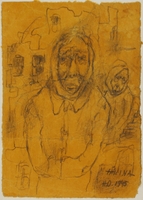
Halina Olomucki sketch of Jewish men whose beards were publicly shaved
Object
Drawing of Jewish men whose beards have been shaved off created by Halina Olszewski (later Olomucki) in 1945, just after the war. It depicts a scene she witnessed while interned in Warsaw Ghetto from October 1940-May 1943. The full beards worn by traditional Orthodox Jewish males as a sign of piety were a convenient target for occupying German troops who would shave off the beards in public, using abusive and humiliating methods. Nazi Germany occupied Poland in September 1939, and, in fall 1940, Halina, her mother Margarit-Hadassa, and siblings were relocated to the ghetto. Halina did forced labor, but she felt her real job was to record the misery and suffering of ghetto residents. Halina smuggled many drawings to a non-Jewish friend outside the ghetto. In May 1943, she and her mother were deported to Majdanek where her mother was killed on arrival. In July, Halina was sent to Auschwitz-Birkenau, where she continued to create art in secret. Other prisoners asked her to draw them or their loved ones to preserve their memory and show the world what happened. She hid artwork in the camp, much of it recovered postwar. On January 18, 1945, Halina was sent by death march to Ravensbrück and Neustadt-Glewe, where she was liberated on May 2, 1945. She returned to Warsaw but found no surviving family members.
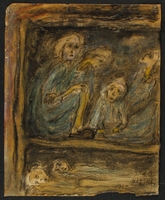
Halina Olomucki drawing of emaciated women prisoners crowded in a barrack
Object
Colored drawing of a bunk crowded with ill and despairing women created by Halina Olszewski (later Olomucki) in Warsaw in 1945, just after the war. It is based upon her experiences as an inmate of the notorious Block 10 in Auschwitz-Birkenau concentration camp from July 1943 to January 1945. Nazi Germany occupied Poland in September 1939, and, in fall 1940, Halina, her mother Margarit-Hadassa, and siblings were relocated to the ghetto. Halina did forced labor, but she felt her real job was to record the misery and suffering of ghetto residents. Halina smuggled many drawings to a non-Jewish friend outside the ghetto. In May 1943, she and her mother were deported to Majdanek where her mother was killed on arrival. In July, Halina was sent to Auschwitz-Birkenau, where she continued to create art in secret. Other prisoners asked her to draw them or their loved ones, to preserve their memory and show the world what happened. She hid artwork in the camp, much of it recovered postwar. On January 18, 1945, Halina was sent by death march to Ravensbrück and Neustadt-Glewe, where she was liberated on May 2, 1945. She returned to Warsaw but found no surviving family members.
Halina Olomucki drawing of concentration camp inmate carrying a rock
Object
Drawing of a female prisoner created in Birkenau concentration camp by Halina Olszewski, 24, (later Olomucki) where she was an inmate from July 1943-January 1945. It depicts an emaciated woman in a striped uniform carrying a rock. Concentration camp prisoners were often forced to carry heavy rocks back and forth for hours. After Nazi Germany occupied Poland in September 1939, Halina, her mother Margarit-Hadassa, and siblings were interned in Warsaw Ghetto. Hannah did forced labor, but she felt her real job was to record the misery and suffering of ghetto residents. Halina smuggled drawings to a non-Jewish friend outside the ghetto. In May 1943, she and her mother were sent to Majdanek where her mother was killed on arrival. Halina was selected for labor. In July, she was transferred to Auschwitz-Birkenau. After she was put on an art detail, she hid pencil stubs and using any paper she could find, secretly drew pictures of camp life. Other prisoners asked her to draw them or their loved ones to preserve their memory and show the world what happened. She hid artwork in the camp, much of it recovered postwar. On January 18, 1945, Halina went by death march to Ravensbrück and Neustadt-Glewe, where she was liberated on May 2, 1945. She returned to Warsaw and found no surviving family members.
Halina Olomucki drawing of an anquished women holding an infant
Object
Pencil drawing of a desperate woman with an infant in the Warsaw Ghetto created by Halina Olszewski (later Olomucki) in Warsaw just after the war. After Nazi Germany occupied Poland in September 1939, Halina, her mother Margarit-Hadassa, and siblings were interned in Warsaw Ghetto. Hannah did forced labor, but she felt her real job was to record the misery and suffering of ghetto residents. Halina smuggled drawings to a non-Jewish friend outside the ghetto. In May 1943, she and her mother were sent to Majdanek where her mother was killed on arrival. Halina was selected for labor. In July, she was transferred to Auschwitz-Birkenau. After she was put on an art detail, she hid pencil stubs and using any paper she could find, secretly drew pictures of camp life. Other prisoners asked her to draw them or their loved ones to preserve their memory and show the world what happened. She hid artwork in the camp, much of it recovered postwar. On January 18, 1945, Halina went by death march to Ravensbrück and Neustadt-Glewe, where she was liberated on May 2, 1945. She returned to Warsaw and found no surviving family members.
Halina Olomucki portrait of a resistance fighter
Object
Drawing created by Halina Olszewski (later Olomucki) in Warsaw after the war. After Nazi Germany occupied Poland in September 1939, Halina, her mother Margarit-Hadassa, and siblings were interned in Warsaw Ghetto. Hannah did forced labor, but she felt her real job was to record the misery and suffering of ghetto residents. Halina smuggled drawings to a non-Jewish friend outside the ghetto. In May 1943, she and her mother were sent to Majdanek where her mother was killed on arrival. Halina was selected for labor. In July, she was transferred to Auschwitz-Birkenau. After she was put on an art detail, she hid pencil stubs and using any paper she could find, secretly drew pictures of camp life. Other prisoners asked her to draw them or their loved ones to preserve their memory and show the world what happened. She hid artwork in the camp, much of it recovered postwar. On January 18, 1945, Halina went by death march to Ravensbrück and Neustadt-Glewe, where she was liberated on May 2, 1945. She returned to Warsaw and found no surviving family members.
Halina Olomucki drawing of a tormented woman behind bars
Object
Drawing created by Halina Olszewski (later Olomucki) in Warsaw after the war. After Nazi Germany occupied Poland in September 1939, Halina, her mother Margarit-Hadassa, and siblings were interned in Warsaw Ghetto. Hannah did forced labor, but she felt her real job was to record the misery and suffering of ghetto residents. Halina smuggled drawings to a non-Jewish friend outside the ghetto. In May 1943, she and her mother were sent to Majdanek where her mother was killed on arrival. Halina was selected for labor. In July, she was transferred to Auschwitz-Birkenau. After she was put on an art detail, she hid pencil stubs and using any paper she could find, secretly drew pictures of camp life. Other prisoners asked her to draw them or their loved ones to preserve their memory and show the world what happened. She hid artwork in the camp, much of it recovered postwar. On January 18, 1945, Halina went by death march to Ravensbrück and Neustadt-Glewe, where she was liberated on May 2, 1945. She returned to Warsaw and found no surviving family members.
Halina Olomucki drawing of partisans beginning an action
Object
Color drawing of abstract figures crouched behind a wall created by Halina Olszewski (later Olomucki) after the war in 1947 expressing her feelings about the Warsaw Ghetto Uprising in January-April 1943. Nazi Germany occupied Poland in September 1939, and, in fall 1940, Halina, her mother Margarit-Hadassa, and siblings were relocated to the ghetto. Halina did forced labor, but she felt her real job was to record the misery and suffering of ghetto residents. Halina smuggled many drawings to a non-Jewish friend outside the ghetto. In May 1943, she and her mother were deported to Majdanek where her mother was killed on arrival. In July, Halina was sent to Auschwitz-Birkenau, where she continued to create art in secret. Other prisoners asked her to draw them or their loved ones, to preserve their memory and show the world what happened. She hid artwork in the camp, much of it recovered postwar. On January 18, 1945, Halina was sent by death march to Ravensbrück and Neustadt-Glewe, where she was liberated on May 2, 1945. She returned to Warsaw but found no surviving family members.



